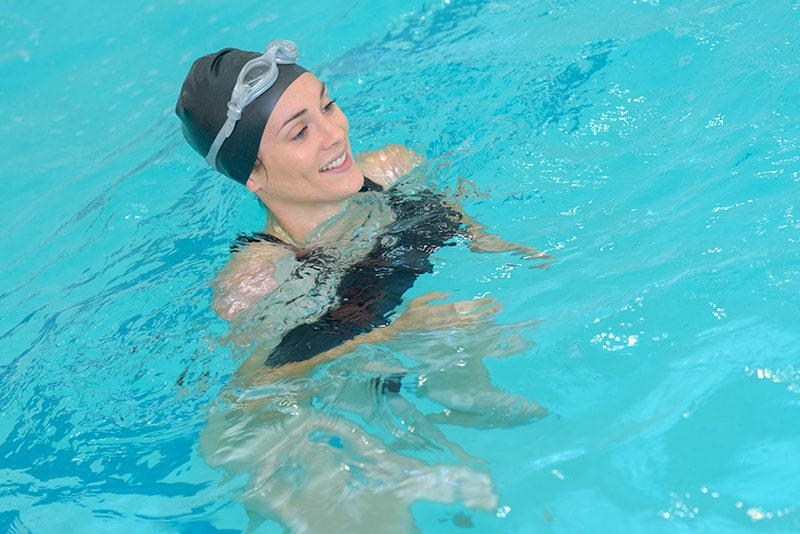Being in the water can be a lot of fun, as long as you know how to swim or stay in a shallow area.
Most everyone feels comfortable in the water as long as their feet can touch the bottom and their head is sufficiently out of the water.
However, there may be times you find yourself in water where you cannot touch.
Your options are to swim or tread water.
Treading water can be almost effortless if you know how to do it properly.
What Does it Mean to Tread Water?

Treading water means that you are able to stay upright and balanced in water without moving in any direction.
It is a technique that allows you to conserve energy and keep your head above water.
When you are treading water properly, your head is above water, and you are able to breathe easily.
When you become proficient at treading water, you can feel safe and confident.
There are many styles and techniques that can be used to tread water.
As long as the method allows you to stay upright, not really moving, and relaxed, you are treading water.
Many people drown because they panic and become stiff after moving around franticly.
Treading helps you stay calm and conserve energy.
How to Tread Water
An experienced swimmer can tread water using just the legs or the arms.
However, a beginner swimmer typically will use both arms and legs.
Doggie Paddle
This is probably the most well-known treading water technique.
It is the most intuitive, and people revert to this technique without ever really being taught it.
However, it works well and can help you stay afloat and prevent you from drowning.
In this technique, your stomach is down, and you are moving your arms and legs around randomly.
Keep in mind; you are not moving your hands around in the air.
You want to keep them in the water and ensure your head remains above water.
Eggbeater Kick
This is a complex technique but also the most efficient.
This technique is intended to mimic the motion of an egg beater, hence the name.
For this style, you must remain upright in the water.
You are going to put yourself in a seated position in the water.
The way you do this is to bend your legs so that your thigh is parallel to the bottom of the pool.
Your thighs should create a 90-degree angle with the back of the pool.
The back should also be perpendicular to the bottom of the pool.
Once you are in this position, open your knees as far as they naturally go.
From this position, you want to circle the lower part of your leg while the rest of your body stays in position.
Your legs should be circling in opposite directions.
One moves clockwise while the other moves counterclockwise.
Your legs should not meet in the middle.
When one leg is moving to the middle of your body, the other one is moving out.
This technique does not use your arms, but you can put them out and move them up and down or back and forth to help you get started.
If you use your arms, you will be expended a lot of energy.
This technique takes practice, and you want to work on it for about 10 minutes per day.
Bicycle Kick
For this technique, you can pretend you are riding a bike.
You want to create a complete circle with the pedaling motion just like you would on a bike.
When you alternate your feet, you will give yourself enough force to stay afloat.
You have to remain upright while creating the circular motions.
You may feel yourself begin to fall to the side.
You may need to use your arms in a backward circle to help steady you.
This technique is instinctual and quick to learn.
Flutter Kick
This technique requires you to keep your legs straight while alternating one leg in front of the other like you are walking.
The kicking motion acts as propulsion that keeps you upright and above water.
With this technique, you may feel yourself lean to one side.
You may need the use of your hands to help keep you upright.
Frog Kick
The frog kick is a propulsion technique also.
It is commonly used in swim strokes.
This technique may require you to use more energy, but it is an effective technique.
In this version, you mimic the motion of a frog with your legs to create an upward thrust to keep you above water.
In this technique, you pull your legs together so that you are completely upright.
Then, you bring your feet in and up while keeping them together.
Finally, you will bring them close to your bottom.
When you do that, your knees will move out and away from your body.
When you pull your feet in so much that they almost touch your bottom, you kick out and down at the same time to create the upward thrust to keep you above water.
While your feet are moving, your arms should be horizontal and circling.
This will help you stay above water.
Treading for Exercise
While treading water is a great way to save yourself from drowning and keeping yourself afloat in the water, it is also a great form of exercise.
Treading intervals helps you burn a large number of calories.
You can tread water as hard as possible for 30 seconds.
You can use any method you prefer.
Once the 30 seconds ends, slow down or float for 30 seconds.
Then, you can start the process again.
Treading Water Drills
The video below provides drills that beginners can use to work their way up to independent treading.
